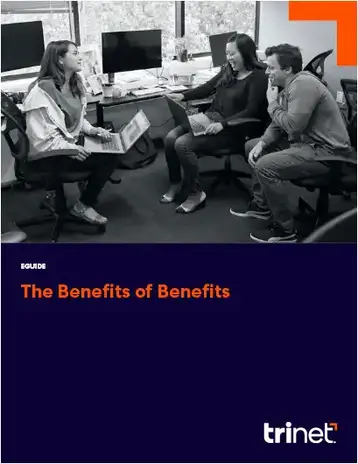
Understanding the mountain of requirements and rules regarding health insurance policies can be overwhelming. In this comprehensive guide for employers and employees, we'll explain some of the most important areas of health insurance.
This guide is designed to help you gain clear insights into health insurance policies. We will cover such matters as:
- What is an allowable amount for insurance claims?
- Do employees need a Social Security number to enroll in health insurance coverage?
- How do health insurance companies determine employer costs?
- What is an employee's insurance effective date?
- Waiting periods for health insurance
- Imputed income for life insurance and AD&D plans
The difference between calendar year and plan year
When it comes to deductibles, it’s calendar year vs. plan year.
The deductible limit is the maximum amount in a given year that a plan participant will have to pay out-of-pocket before the insurance begins to pay. This does not include premiums or costs that are not covered by your plan.
A calendar year deductible, which is what most health plans operate on, begins on January 1 and ends on December 31. Calendar-year deductibles reset every January 1.
A plan year deductible resets on the renewal date of your company’s plan. For example, if an employee’s health plan renews on May 1, then their deductible would run from May 1 to April 30 of the following year, and reset on May 1.
A carrier will specify this in its health insurance policy contracts. Employees can contact their HR department, broker, or carrier for this information.
The difference between calendar year and plan year
When it comes to deductibles, it’s calendar year vs. plan year.
The deductible limit is the maximum amount in a given year that a plan participant will have to pay out-of-pocket before the insurance begins to pay. This does not include premiums or costs that are not covered by your plan.
A calendar year deductible, which is what most health plans operate on, begins on January 1 and ends on December 31. Calendar-year deductibles reset every January 1.
A plan year deductible resets on the renewal date of your company’s plan. For example, if an employee’s health plan renews on May 1, then their deductible would run from May 1 to April 30 of the following year, and reset on May 1.
A carrier will specify this in its health insurance policy contracts. Employees can contact their HR department, broker, or carrier for this information.
What is an allowable amount for insurance claims?
The allowable amount (also referred to as allowable charge, approved charge, or eligible expense) is the dollar amount that is typically considered payment-in-full by an insurance company and an associated network of healthcare providers.
The actual amount is typically a discounted rate (agreed on by the provider and carrier) rather than the actual charge for health care services. Subscribers may be responsible for the difference if their provider charges more than the allowable amount for services not covered under a plan’s Summary of Benefits and Coverage (SBC).
Here’s an example case:
David sees his doctor for an earache. The doctor is a provider in the network for David’s plan. The total charge for the visit comes to $100.
The insurance carrier requires the doctor to accept a fixed amount of $80 as payment in full for the visit—this is the allowable amount. David’s carrier will pay $80 or a portion of that—what's left after any co-pays or deductibles that David must pay. The difference between the doctor's standard charge ($100) and the allowable amount ($80) is considered a provider write-off, and David can't be billed for it.
If the doctor is not an in-network provider, David may be held responsible for everything that his health insurance company will not pay, up to the full charge of $100.
Do employees need a Social Security number to enroll in health insurance coverage?
Health insurance applications normally require a Social Security number (SSN), but certain individuals may present other forms of valid identification.
SSNs are required for employees enrolling in group health coverage through their company. If they do not have an SSN (e.g., in the case of someone working in the United States on a work visa or students on an F-1 Visa), they can use their individual tax ID number (ITIN) instead.
They may also be required to provide one of the following documents, at the carrier’s discretion, to prove that they are legally living in the United States:
- Alien Registered Receipt Card with Photograph (INS Form 1-151 or -551).
- U.S. passport (updated or expired).
- Certificate of U.S. Citizenship (INS Form N-560 or N-561).
- Certificate of Naturalization (INS Form N-550 or N-570).
- Updated foreign passport with I-551 stamp pr INS Form I-94 indicating unexpired employment authorization.
- Updated Temporary Resident Card (INS Form I-688).
- Updated Employment Authorization Card (INS Form I-688A).
- Updated Reentry Permit (INS Form 1-327).
- Updated Refugee Travel Documents (INS Form I-571).
- Updated Employment Authorization Document issued by the INS which contains a photograph (INS Form I-688B).
How health insurance companies determine employer costs
Studies show that 56% of small businesses offer health insurance to at least a portion of their employees. Assuming the health insurance plan is fully insured, how does the insurer set the employer’s rates?
The first thing to understand is that if your business is a small employer/group, the insurance company must follow the Affordable Care Act (ACA), plus applicable state regulations, when calculating the cost of health insurance.
Defining small employer/group
The ACA employer mandate designates a small employer as a business with 1-50 full-time (or full-time equivalent) employees. These businesses are exempt from the employer-shared responsibility provisions of the ACA.
However, the ACA’s small group market reforms impacting premium rates define a small employer as a business with 1–100 employees. Most states regard businesses with 1–50 employees as a small group. Some states, including California and New York, define small groups as businesses with 1–100 employees.
Employers in the small group market can calculate health insurance rates only according to:
- Age of employees and their dependents
- Tobacco use
- Business location
- Family size
Age
The ages of employees and their dependents is usually the biggest factor in figuring a group’s health insurance premiums. Under the ACA, premiums for older people can be up to 3 times higher than the rate for younger people. Since the base rate is the cost for a 21-year-old, older people can be charged up to 3 times the rate for a 21-year-old.
States are allowed to create their own small group rates based on age, provided the amount does not exceed the 3:1 ratio.
Premiums tend to rise as group members get older, with the biggest increases occurring after age 55.
Tobacco use
The ACA allows small group health plans to charge tobacco users up to 50% more than non-tobacco users if the employer provides a tobacco cessation program and the employee declines to participate in the program. Certain states, including California, Connecticut, Massachusetts, New Jersey, and New York, forbid tobacco use surcharges. Some insurers do not take tobacco use into account when determining employer premiums.
For surcharge purposes, the ACA defines tobacco use as “use of a tobacco product or products four or more times per week within no longer than the past six months.”
Business location
Insurers can establish small group health insurance premiums according to the employer’s geographic location. When calculating the cost of health insurance, the insurer can consider geographic factors such as the region’s healthcare expenditures. For this reason, different regions in the same state can have different rates.
However, insurers are not allowed to vary premiums because of differences in health status. This means your insurance company cannot charge higher premiums in your region just because the residents there tend to have more serious health conditions. Circumstances under which the insurer can modify geographic factors — and, by extension, pricing — include:
- The healthcare provider has changed its pricing.
- The region is undergoing unique changes in medical management.
- There’s been an increase or decrease in the number of regions in which the health plan will be offered.
Family size
The ACA lets insurance companies vary premiums by family size—which means they can charge more for co-insurance spousal and dependent coverage. On average, premiums for single coverage rose 4% and premiums for family coverage increased 5% over the past year, according to a 2019 survey by the Kaiser Family Foundation (KFF).
Factors that cannot influence small group rates
The ACA prohibits insurers from establishing small-group insurance premiums based on:
- Enrollees’ medical history.
- Enrollees’ gender
- The group’s industry.
- The group’s medical claims history.
Type of plan and level of coverage
Whether the ACA applies to your business or not, the type of plan and level of coverage play a role in your health insurance rates. The most common types of health insurance plans are:
Health Maintenance Organization (HMO): With a lower premium and deductible, an HMO is one of the cheapest forms of health insurance. Enrollees can save money but must use doctors within the HMO network.
Point of Service (POS): Premiums for POS plans are usually a bit higher than for HMO plans. Enrollees can visit doctors outside the network but must pay more for that service. To see a specialist, they must get a referral from their primary care physician.
Preferred Provider Organization (PPO): With a PPO plan, premiums are normally higher than HMO and POS plans. Enrollees do not need a referral to see out-of-network doctors and specialists.
Per the 2019 KFF survey, 75% of companies that provide health insurance offer only 1 type of plan. (Large companies are more likely to offer multiple plan types.) Also, many insurance carriers limit very small employers to only 1 plan type until more people are enrolled in the plan.
Level of coverage
Employees’ needs differ when it comes to medical services. Some may rarely visit the doctor and need only catastrophic coverage to help pay for accidents or unexpected illnesses. Others, or their dependents, may have chronic illnesses, such as diabetes or asthma.
You can offer different levels of coverage to suit the needs of your employee population and your budget. However, more extensive coverage and lower out-of-pocket costs generally yield higher premiums. Your premiums will also increase if you include other benefits like dental and vision insurance or extra health coverage.
Midsize and large employers
For companies with 51 or more employees, the insurance company can base premiums on:
- The group’s claims history.
- Industry.
- Enrollees’ occupation type.
- The gender of the workforce.
- Enrollees’ age.
- Business location.
- The level of coverage.
For example, large claims caused by lengthy hospital stays and expensive surgery can trigger higher premiums. Premiums for construction workers may be greater than premiums for employees in a retail clothing store.
Note that some states define a large group as a business with 101 employees or more.
Typically, large employers can offer their employees lower premiums because the risk is spread out across everyone in the plan. However, a large employer can incur inflated costs if their risk pool has a disproportionate amount of high-cost claims and no offset mechanism. For example, high-cost claims might be offset by enrolling a significant number of lower-cost individuals, thereby lowering premiums.
In the end, health insurance costs depend on the insurance company’s calculation. What goes into that calculation varies according company size, business location, type of plan, level of coverage, and whether ACA rules apply.
The cost of adding a dependent to your health insurance
During open enrollment, employees can see how much it would cost to add dependents to their health insurance plans.
Outside of open enrollment, the only way to add dependents is through a qualifying life event. Employees usually have a maximum number of days after the triggering event to enroll a dependent in their plan.
What is an employee's insurance effective date?
The insurance effective date is calculated based on an employee’s hire date and the waiting period set in place by their employer at the time of renewal.
For example, if an employer has a waiting period of “First of the following month” and an employee’s hire date is 10/23/2023, their insurance effective date will be calculated to 11/01/2023.
Waiting periods for health insurance
A waiting period is the length of time that employees must work at a company before their health insurance covers medical expenses. Employers decide what the waiting period will be, but it cannot exceed 90 days, according to the Affordable Care Act.
Waiting periods:
- Begin when an employee officially becomes “benefits-eligible,” so a new hire or an employee moving from part-time to full-time will need to satisfy their waiting period from their first day as a full-time employee.
- Can be changed mid-year per the carrier’s discretion.
- Cannot be changed for only 1 employee.
The available waiting period choices for an administrator will depend on carrier restrictions and state laws. Some states do not allow 90-day waiting periods.
There can be different waiting periods for each line of coverage offered, but not for different plans under the same coverage type.
- A company can set a “First of the month following hire date” waiting period for medical and a 60-day waiting period for dental and vision.
- The company cannot set a 30-day waiting period for their medical HMO, a 60-day waiting period for their medical PPO, and “First of the month following hire date” for their medical HDHP option.
Health insurance rate structures
Health insurance premiums are assigned based on the employee’s family type and gender, with a distinction between an employee with a single child versus multiple children. Here are acronyms and their meanings:
- Employee (Male): Male EE
- Employee (F): Female EE
- Employee + Spouse: EE+SP
- Employee + 1 Child: EE+CH
- Employee + 2 or more Children: EE+Children
- Family (gender unspecified): EE+Family
Imputed income for life insurance and AD&D plans
Imputed income is the cash value of benefits that an employee receives, outside their normal taxable wages, but doesn't pay anything for. Group life insurance and accidental death & dismemberment coverage (AD&D) are examples, as well as company cars, company trips, gym membership and adoption assistance.
Imputed income for group-term life insurance
The first $50,000 of coverage volume for any life insurance plan is a tax-free benefit for employees. If an employee’s Basic Life plan volume is greater than $50,000, the IRS calculates imputed income for the value of the premium paid by the employer for the excess coverage, and adds this amount to the employee’s gross income.
If an employee’s Voluntary Life plan volume is greater than $50,000 and the employee’s rate falls below the IRS rates stated in Publication 15-B Table 2-2, the IRS may calculate imputed income for the value of the difference in premium paid by the employee for the excess coverage, and add this amount to the employee’s gross income.
Imputed income applies to the value of the premium paid by the employer for the coverage volume, and not the actual death benefit paid to beneficiaries.
What is imputed income for life insurance and AD&D plans?
If your life insurance plan covers an employee at 1x their base salary and their gross base salary is $75,000 per year, $25,000 of that policy would be used to perform the calculation for imputed income, based on the amount of the premium for that extra coverage.
However, if the policy bundles the group life, at 1x the employee’s salary, and the accidental death and dismemberment policy (AD&D), with a similar maximum payment potential, the imputed income calculation would be limited to the $25,000 discussed above. The two plan values do not need to be combined to calculate the imputed income.
Company-paid AD&D plan values are not considered imputed income because of the following:
- Nature of the plan.
- Various levels of payment, depending on the specific injury.
Why is imputed income for life insurance and AD&D plans important for my business?
Employers must understand the importance of imputed income because it means the difference between correctly and incorrectly reporting this portion of your business' and employees’ taxes. Life insurance policy values are not the only area where benefits and perks are considered imputed income. Some additional examples include:
- Adoption assistance over a certain tax-free maximum.
- Any non-business use of an employer-provided cell phone.
- Care assistance for an employee’s dependents over a certain tax-free maximum.
- Employee education assistance over a certain tax-free maximum.
- Gym memberships or other fitness-related perks.
- Moving expenses that aren’t tax-deductible.
- Non-bonus cash and gift cards (bonus tax is separate from imputed income tax).
- The addition of an employee’s non-dependents to their employer-paid health insurance plan.
- Transportation benefits above employer and employee pre-tax deferrals under a Section 132 Plan.
- Vehicles provided to employees (whether you own or lease them) for regular non-business use.
The consideration of the imputed income of these additional benefits results in a total compensation, or total rewards amount you are actually paying the employee. Few team members understand the significant value these perks give them.
Your ability to capture this information and provide a total rewards statement that includes their cash compensation along with their imputed income value can be an eye-opening experience.
Help with health insurance basics, and more
TriNet's rich employee benefit plans go beyond access to exceptional health and retirement coverage to include benefits such as critical accident and illness policies, access to auto and home policies, commuter benefits and more.
That helps small and medium-sized businesses offer big-league benefits that draw and retain top talent. But TriNet also provides risk mitigation services that protect your business and assure you that complex employment-related regulations and compliance will be taken care of.






